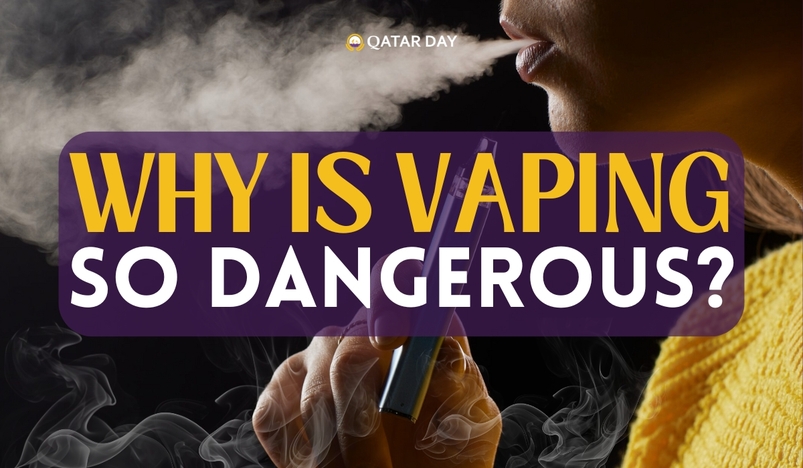
Vaping has quickly become a popular alternative to traditional smoking, especially among younger generations.
With its sleek design, flavorful options, and perceived safety compared to cigarettes, many assume it's a harmless habit.
But beneath the vapour clouds lies a growing body of evidence that vaping is far more dangerous than it seems.
Let’s dive into why vaping poses significant risks to your health.
The liquid used in e-cigarettes, known as e-juice, typically contains nicotine, flavourings, and other chemicals. While some believe that inhaling vapor is safer than smoking, research shows that vaping can still expose users to harmful substances. These include:
Formaldehyde: A toxic chemical used in building materials, which can form when the e-liquid is heated.
Acrolein: Used in herbicides, this chemical can cause irreversible lung damage.
Diacetyl: Commonly found in flavourings, this compound has been linked to “popcorn lung,” a condition that damages the smallest airways of the lungs.
Though e-cigarettes eliminate some of the toxins found in traditional cigarettes, they introduce new and equally harmful chemicals into the body.
E-liquids often contain nicotine, the highly addictive substance found in traditional tobacco products. Nicotine addiction can lead to increased cravings, difficulty concentrating, and withdrawal symptoms. For teenagers and young adults, the risks are even higher. Vaping during adolescence can harm the developing brain, particularly the regions responsible for attention, learning, and impulse control.
Moreover, young users who start with vaping may be more likely to transition to traditional cigarettes, undoing years of anti-smoking efforts.
A significant concern surrounding vaping is its impact on lung health. While e-cigarettes do not produce tar-like traditional cigarettes, they can still cause lung damage. Several cases of severe lung disease, known as EVALI (e-cigarette or vaping product use-associated lung injury), have been reported, with symptoms ranging from chest pain and shortness of breath to fever and fatigue. Some of these cases have resulted in hospitalization or death.
The root cause is believed to be a combination of harmful chemicals in vaping products, particularly those that contain THC (the psychoactive component of marijuana), but even nicotine-based vapes pose risks.
Vaping doesn’t just affect the lungs; it also has a detrimental impact on the heart. Studies have found that vaping can increase heart rate and blood pressure, similar to the effects of traditional cigarettes. The presence of nicotine leads to the narrowing of blood vessels, which can increase the risk of a heart attack or stroke. Additionally, some chemicals in e-liquids may cause inflammation and oxidative stress in the body, further contributing to cardiovascular diseases.
One of the biggest dangers of vaping is its perceived harmlessness. Many people believe that because it doesn't produce the same foul odor or visible smoke as cigarettes, it’s safer. The marketing of e-cigarettes as a cleaner, more modern alternative to smoking has contributed to this misconception. However, the absence of traditional smoke doesn’t mean vaping is harmless. The long-term effects are still being studied, but emerging evidence suggests that regular vaping can lead to many of the same health problems associated with smoking.
Unlike traditional tobacco products, which have been subject to strict regulations and public health campaigns, vaping products are relatively new and remain largely unregulated in many regions. This means that users often have little to no idea what exactly they’re inhaling. Poorly manufactured devices, counterfeit cartridges, and untested e-liquids increase the risk of exposure to harmful substances, making vaping even more dangerous.
Vaping may seem like a safer alternative to smoking, but in reality, it comes with a host of health risks. From the toxic chemicals inhaled to the potential for lung and heart damage, vaping is far from harmless. As the long-term effects continue to unfold, it’s essential to understand that vaping is not the risk-free activity many believe it to be.
For those looking to quit smoking, it’s important to explore safer, proven alternatives like nicotine patches, gum, or professional cessation programs.
Vaping may seem like a modern solution, but the dangers it carries are all too real.
.jpg)
Qatar Secures Place Among the World's Top 10 Wealthiest Nations
.jpg)
Hamad International Airport Witnesses Record Increase in Passenger Traffic

Saudi Arabia: Any visa holder can now perform Umrah

What are Qatar's Labour Laws on Annual Leave?
Leave a comment